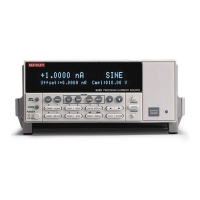Model 6220/6221 Reference Manual DC Current Source Operation 3-7
Return to Section 3 topics
The FAST setting allows a faster output response. The FAST response setting
changes the maximum output response bandwidth of the Model 6221 to 1MHz. It
also reduces stability. The output will remain stable into a 10µHz (typical) load. For
a more complex load, the faster speed may make the test system more suscepti-
ble to oscillation.
Note that output stability into an inductive load is only dependent on the response
mode setting and is not affected by the analog filter (on or off).
Again, experimentation may be the best way to determine which response setting
(FAST or SLOW) provides the best results.
Settling time specifications
The output “settling time” specifications are listed in Appendix A and assume that
the analog filter is disabled. For the Model 6221, settling times are provided for the
FAST and SLOW response speed settings. Note that the SLOW setting of the
Model 6221 has the same response as the Model 6220. Enabling the analog filter
may or may not significantly increase settling times. For details, see “Analog filter,”
on page 3-5.
The listed settling times in Appendix A are specified for a resistive load. The max-
imum load resistance for the specified settling times is calculated as follows:
Max Load Resistance = 2V / I
FULL SCALE OF RANGE
For example, on the 20mA range, the max load resistance is calculated as follows:
Max Load Resistance = 2V / 20mA = 100Ω
The settling times for other load conditions are calculated as explained in the fol-
lowing paragraphs.
100mA, 20mA, 2mA, 200µ, 20µA, and 2µA ranges
Model 6220 and Model 6221 slow mode:
Where:
ST is the settling time in microseconds.
Ifs is the full scale of range current in amps.
Rl is the load resistance in ohms.
NOTE All settling times are typical into a resistive load
to 1% of final value.
ST 10
10.5IfsRl××+()1+log[]
=
Test Equipment Depot - 800.517.8431 - 99 Washington Street Melrose, MA 02176 - TestEquipmentDepot.com

